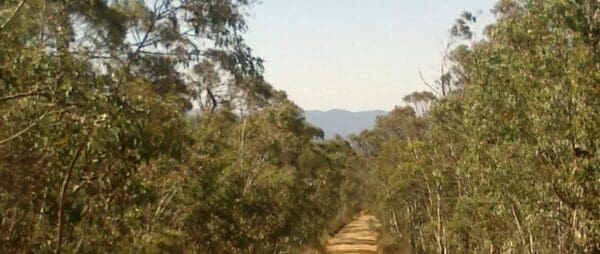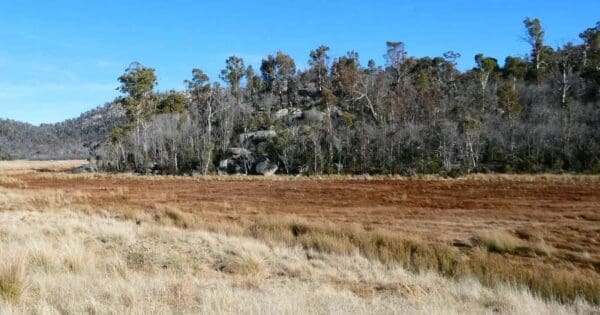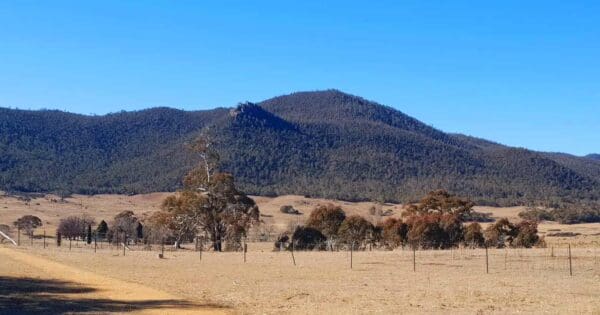Hike at a Glance
Max elevation: 1311m
Min elevation: 1142m
Total Ascent: 477m
Hike overview
The Grassy Creek to Boboyan Valley loop trail is a challenging 25-kilometre (grade 4) circuit hike located within Namadgi National Park. This trek typically takes around 8 hours to complete and offers a glimpse into the region's rich pastoral heritage.
The journey begins on Boboyan Road and follows the Grassy Creek Fire Trail, traversing scenic rural landscapes and eucalypt woodlands. Keep your eyes peeled for remnants of the area's past, including historic huts, ruins, stockyards, and even some exotic plant species.
Several noteworthy historic sites dot the trail. Your first stop will likely be Westermans Homestead, famed for its decorative bargeboards and stone chimneys. Continuing alongside Grassy Creek, the route offers a chance to detour to Waterholes Hut, where you'll find old sheep yards and horse stalls. As you skirt the border and delve into the eucalypt forest, Lone Pine Homestead comes into view. Erected around 1890 by Dan Crawford, this homestead served as a home for him and his family. Legend suggests a lone pine tree was planted alongside the hut during this period. The final historic stop, Luton's Crutching Shed, is an optional side trip. Built in 1964, this structure was used to shear sheep.
Be mindful of weather conditions, especially during winter. Checking the forecast beforehand can help ensure your safety in the event of storms or sudden temperature drops. Additionally, expect to encounter wet sections on the trail. Packing an extra pair of socks or opting for waterproof boots is recommended for these areas.
Before setting off, it's important to acknowledge the traditional custodians of this land, the Ngunnawal people, and pay respects to their elders past and present.
Track grade
Grade 4 (Hard) - Challenging Walks for Experienced Walkers: Grade 4 on the AWTGS signifies challenging walking tracks. Bushwalking experience is recommended for these tracks, which may be long, rough, and very steep. Directional signage may be limited, requiring a good sense of navigation. These walks are suited for experienced walkers who are comfortable with steeper inclines, rougher terrain, and potentially longer distances.
Walk map and GPX file
Max elevation: 1311 m
Min elevation: 1142 m
Total climbing: 477 m
Total descent: -477 m
Content use
Please don’t copy GPX files or content from this site to AllTrails or other platforms. Each trail has been personally mapped, documented, and refined to support Australia’s bushwalking and hiking community. While some details come from land managers, every listing reflects significant personal effort. This is a free, community-driven initiative—your respect helps keep it that way.
Gallery
Got any photos from this hike? Your photos can help others plan. Share shots from along the trail so fellow hikers know what to expect.
Click to add your photos >>
Getting there
Getting to the trailhead: Namadgi National Park.
Accessing the Grassy Creek to Boboyan Valley loop trail requires reaching either the northern or southern trailhead. The northern trailhead is situated on Boboyan Road, a short distance from the ACT-NSW border near Mount Clear. From Tharwa, head south along Naas Road for roughly 36 kilometres. You’ll see Boboyan Road branching off to the left shortly after this point. Follow Boboyan Road for a few more kilometres until you reach the designated carpark for the trailhead. The southern trailhead is located on Old Boboyan Road near Naas Creek. If approaching from Tharwa, take a similar route along Naas Road, turning left onto Old Boboyan Road a few kilometres after passing the turnoff for Boboyan Road. The carpark for the southern trailhead will be on your right. Remember, both Boboyan Road and Old Boboyan Road are unsealed surfaces, so adjust your driving speed accordingly.
Need a rental car to get you to the hike? Find one here.
About the region
The Namadgi National Park lies on Ngunnawal Country. This land, rich in cultural significance, has been managed by the Ngunnawal people for countless generations. Their deep connection to this landscape encompasses cultural, social, environmental, spiritual and economic aspects.
Encompassing over 106,000 hectares, Namadgi National Park safeguards a vast area of alpine, sub-alpine and mountain bushland. Nearly half of the Australian Capital Territory falls within its boundaries. The park is crucial for the preservation of high-altitude sphagnum bogs. These bogs provide critical habitat for endangered species and act as natural reservoirs, slowly releasing clean water that sustains the ACT.
For visitor information, maps, firewood permits, or general inquiries, head to the Namadgi Visitor Centre.
Hikers will find hundreds of kilometres of trails to explore within Namadgi National Park. Before venturing out, it's important to familiarise yourself with the Australian Walking Track Grading System. Additionally, inform someone of your planned route and estimated return time. Be sure to record your trip details in the designated bushwalking registers located throughout the park. Straying from marked trails is only recommended for experienced navigators with proper map and compass skills. As weather conditions in the mountains can change rapidly year-round, always pack warm and waterproof clothing.
Namadgi National Park is home to numerous significant Ngunnawal cultural sites and objects scattered across the landscape. These include the Yankee Hat Rock Art and other locations that hold stories of vital knowledge, cultural values, and wisdom. These sites are deeply important to the Ngunnawal people. Their history is not only documented in archaeological finds but also preserved in the landscape itself, passed down through generations through oral stories, dance, memory, ceremonies and the artistic depictions found in rock art sites.
The Ngunnawal people emphasise the importance of protecting these stories, sites and objects for future generations. Visitors to Namadgi are asked to treat these locations with respect, recognising them as a rich and ancient part of the park's narrative.
Find a place to stay
Wondering where to stay near this hike? Find accommodation close to the trailhead — hotels, cabins and campgrounds nearby. Click the button to view the interactive map.
Closest towns to this walk: Banks, Canberra, Conder, Cotter River, Gordon, Hall, Jerrabomberra, Kambah, Lanyon, Michelago, Narrabundah, O'Malley, Pearce, Queanbeyan, Tharwa, Tidbinbilla, Tuggeranong, Tumut, Uriarra, Uriarra Village, Wanniassa, Watson, Weston Creek, Woden
Let someone know
Heading out? Fill in a trip intentions form so someone knows your plans. If things go wrong, they can raise the alarm fast, giving you peace of mind on the trail.
Similar walks nearby
Looking for more walks in or near Namadgi National Park? Try these trails with a similar difficulty grade.
Suggest an edit
Notice something different about this trail? Whether it’s a new feature, a route change, or a closure, share your update so we can keep our info accurate and helpful for fellow hikers.
Click to suggest edits >>
Explore safe
Plan ahead and hike safely! Carry enough water, pack layers for changing conditions, and bring safety gear like a torch, PLB, and reliable communication device. Check official sources for trail updates, closures, and access requirements, and review local weather and bushfire advice. Most importantly, share your plans with someone before you go. Being prepared makes for a safer and more enjoyable hike! Stay Safe, Explore More, and Always #ExploreSafe.
Packing checklists
What you carry in your pack depends on factors like weather, terrain, and your adventure type. Not sure what to bring? My free planning, food, and packing checklists are a great starting point, covering day hikes, overnight trips, and multi-day adventures. Use them to customise your kit and always prioritise safety.
Acknowledgement of Country
Trail Hiking Australia acknowledges the Traditional Owners of the lands on which we hike and pay respects to their Elders, past and present, and we acknowledge the First Nations people of other communities who may be here today.






